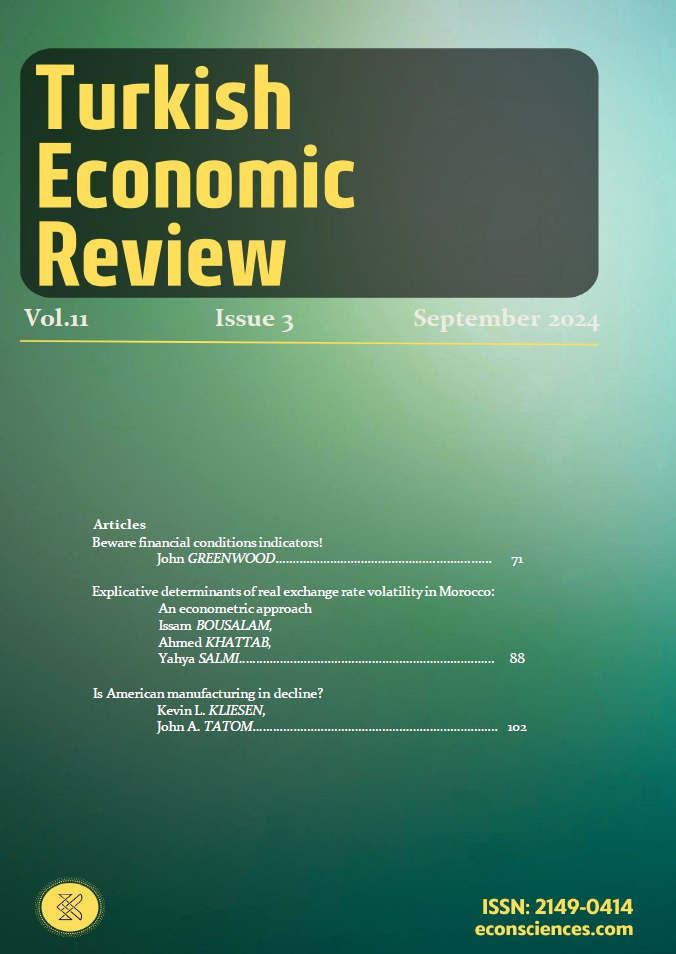Abstract
This paper compares two versions of the transmission mechanism of monetary policy: the monetarist model and the widely popular Financial Conditions Index (FCI) model. The focus is on the role of interest rates and spreads as indicators of the business cycle. In the monetarist model, following a sustained upswing or downswing in the rate of growth of money, theory and evidence point to two subsequent stages for interest rates – first the liquidity effect, followed by the Fisher effect. These two movements are in opposite directions, both being effects of prior monetary growth. The first effect is typically quite brief; the latter effect usually lasts much longer. I find that the monetarist model fits the experience since March 2020 like a glove. By contrast, the FCI model generally ignores monetary growth and constructs an index consisting of a composite of rates, spreads and other financial market indicators. This index is taken as the driver for subsequent moves in asset prices, credit market developments and their impact on the real economy. To my knowledge, the FCI model is nowhere fully articulated and is only vaguely specified in mathematical terms. Based on evidence from business cycle developments since the onset of Covid for the US, the euro-area, and the UK, the FCI results are shown to be inconsistent and sometimes contradictory.
Keywords. Monetary economics; Business cycle; Interest rates; Inflation.
JEL. E19, E32, E52, G10.
References
Bank of England. (2019). How can we measure UK financial conditions? Bank Overground. https://www.bankofengland.co.uk/bank-overground/2019/how-can-we-measure-uk-financial-conditions
Bank of England. (2021). How do we monitor UK financial conditions? Bank Overground. https://www.bankofengland.co.uk/bank-overground/2021/how-do-we-monitor-uk-financial-conditions
Bank of England. (2021). How do we monitor UK financial conditions? Bank Overground. https://www.bankofengland.co.uk/bank-overground/2021/how-do-we-monitor-uk-financial-conditions
Bloomberg. (2023, July 20). Transcript: Mervyn King says the Bank of England is making a big mistake. https://www.bloomberg.com/news/articles/2023-07-20/transcript-mervyn-king-says-the-bank-of-england-is-making-a-big-mistake
Bloomberg. (2022, March 24). Why financial conditions are easing after the Fed raised rates. https://www.bloomberg.com/news/articles/2022-03-24/why-financial-conditions-are-easing-after-the-fed-raised-rates
Boulding, K. (1941). Economic analysis. Harper & Brothers.
Borio, C., et al. (2023). The role of money in inflation. Bank for International Settlements Bulletin, 67. https://www.bis.org/publ/bisbull67.pdf
Broadbent, B. (2023, April). Speech hosted by National Institute of Economic and Social Research. Bank of England. https://www.bankofengland.co.uk/speech/2023/april/ben-broadbent-speech-hosted-by-national-institute-of-economic-and-social-research
Federal Reserve Bank of St. Louis. (n.d.). St. Louis Fed financial stress index [STLFSI4]. FRED, Federal Reserve Bank of St. Louis. https://fred.stlouisfed.org/series/STLFSI4
European Central Bank. (2023, September 25). Keynote address by ECB official [Press release]. https://www.ecb.europa.eu/press/key/date/2023/html/ecb.sp230925_1~7ad8ef22e2.en.html
Financial Times. (2022, November). Report on speech in Italy. https://www.ft.com/content/8981df2f-f723-4a1a-8044-0e7a3e4856a0
Fisher, I. (1906). The nature of capital and income. The Macmillan Company.
Fisher, I. (1907). The rate of interest. The Macmillan Company.
Fisher, I. (1930). The theory of interest. The Macmillan Company.
Friedman, M. (1963). Money and business cycles, section III: A tentative sketch of the mechanism transmitting monetary changes. In M. Friedman, The optimum quantity of money (pp. 229-234). Aldine Transaction. (Reprinted 1996).
Tenreyro, S. (2023, April). Quantitative easing, quantitative tightening [Speech]. Bank of England. https://www.bankofengland.co.uk/speech/2023/april/quantitative-easing-quantitative-tightening-speech-silvana-tenreyro

This work is licensed under a Creative Commons Attribution-NonCommercial 4.0 International License.
